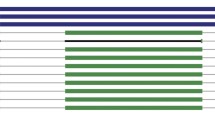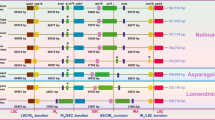Abstract
The gene cox1 is one of the most reported mitochondrial genes involved in horizontal gene transfer among angiosperms. However, whether different cox1 copies exist in different populations of a species and whether any other novel way except intron homing exists for cox1 intron acquisition is less understood. In this study, we chose Cassytha filiformis, a parasitic plant from the angiosperm family Lauraceae, as an example to study cox1 variation and evolution. We identified the stable and inheritable co-occurrence of two copies of cox1 genes, which were different in base composition and insertion/deletion among samples of a single species, C. filiformis. The bioinformatic analyses revealed that Type I copy had intact open reading frames, but type II copy had premature stop codons and was a pseudogene. Further INDEL characterization, phylogenetic analyses, and CCT comparisons consistently support two different origins for the two types of C. filiformis cox1 genes. Type I cox1 was likely vertically inherited within the magnoliids but it has captured an intron from another species, whereas the entire type II intron-containing cox1 has most likely been transferred integrally from Cuscuta or other Convolvulaceae species. The finding of the two independent horizontal gene transfer events associated with C. filiformis cox1 genes not only promotes our understanding of the evolutionary history of C. filiformis, but also leaves intriguing evolutionary questions that merits further efforts.




Similar content being viewed by others
Data Availability
The cox1 fragments sequenced in our study were deposited in NCBI nucleotide database under the accession numbers MH093679-MH093710 and MT010850-MT010851. GenBank accession numbers of C. filiformis type I and type II cox1 are MH093709 and MH093710, respectively.
Abbreviations
- CCT:
-
Co-conversion tract
- HGT:
-
Horizontal gene transfer
- INDEL:
-
INsertion/DELetion
References
Atsatt PR (1973) Parasitic flowering plants: how did they evolve? Am Nat 107:502–510
Barkman TJ, McNeal JR, Lim SH, Coat G, Croom HB, Young ND, dePamphilis CW (2007) Mitochondrial DNA suggests at least 11 origins of parasitism in angiosperms and reveals genomic chimerism in parasitic plants. BMC Evol Biol 7:248
Belfort M, Perlman PS (1995) Mechanisms of intron mobility. J Biol Chem 270:30237–30240
Bergthorsson U, Richardson AO, Young GJ, Goertzen LR, Palmer JD (2004) Massive horizontal transfer of mitochondrial genes from diverse land plant donors to the basal angiosperm Amborella. Proc Natl Acad Sci USA 101:17747–17752
Cho Y, Palmer JD (1999) Multiple acquisitions via horizontal transfer of a group I intron in the mitochondrial cox1 gene during evolution of the Araceae family. Mol Biol Evol 16:1155–1165
Cho Y, Qiu YL, Kuhlman P, Palmer JD (1998) Explosive invasion of plant mitochondria by a group I intron. Proc Natl Acad Sci USA 95:14244–14249
Cusimano N, Zhang LB, Renner SS (2008) Reevaluation of the cox1 group I intron in Araceae and angiosperms indicates a history dominated by loss rather than horizontal transfer. Mol Biol Evol 25:265–276
Davis CC, Xi Z (2015) Horizontal gene transfer in parasitic plants. Curr Opin Plant Biol 26:14–19
Delahodde A, Goguel V, Becam AM, Creusot F, Perea J, Banroques J, Jacq C (1989) Site-specific DNA endonuclease and RNA maturase activities of two homologous intron-encoded proteins from yeast mitochondria. Cell 56:431–441
Gyles C, Boerlin P (2014) Horizontally transferred genetic elements and their role in pathogenesis of bacterial disease. Vet Pathol 51:328–340
Katoh K, Rozewicki J, Yamada KD (2017) MAFFT online service: multiple sequence alignment, interactive sequence choice and visualization. Brief Bioinform 20:1160–1166
Kay E, Vogel TM, Bertolla F, Nalin R, Simonet P (2002) In situ transfer of antibiotic resistance genes from transgenic (transplastomic) Tobacco plants to bacteria. Appl Environ Microbiol 68:3345–3351
Kearse M et al (2012) Geneious basic: an integrated and extendable desktop software platform for the organization and analysis of sequence data. Bioinformatics 28:1647–1649
Keeling PJ, Palmer JD (2008) Horizontal gene transfer in eukaryotic evolution. Nat Rev Genet 9:605
Koonin EV, Makarova KS, Aravind L (2001) Horizontal gene transfer in prokaryotes: quantification and classification. Annu Rev Microbiol 55:709–742
Lalitha S (2000) Primer premier 5. Biotech Softw Internet Rep 1:270–272
Lambowitz AM, Belfort M (1993) Introns as mobile genetic elements. Annu Rev Biochem 62:587–622
Li Q, Yao D, Cai J, Huang L (1992) A field survey of Cassytha filiformis host range. Guangxi Plant Protection 4:21–24
Miller MA, Pfeiffer W, Schwartz T (2010) Creating the CIPRES Science Gateway for inference of large phylogenetic trees. In: grid computing environments. Accessed 14 Nov 2010
Molina J et al (2014) Possible loss of the chloroplast genome in the parasitic flowering plant Rafflesia lagascae (Rafflesiaceae). Mol Biol Evol 31:793–803
Mueller JE, Smith D, Belfort M (1996) Exon coconversion biases accompanying intron homing: battle of the nucleases. Genes Dev 10:2158–2166
Park S, Grewe F, Zhu A, Ruhlman TA, Sabir J, Mower JP, Jansen RK (2015) Dynamic evolution of Geranium mitochondrial genomes through multiple horizontal and intracellular gene transfers. New Phytol 208:570–583
Rice DW et al (2013) Horizontal transfer of entire genomes via mitochondrial fusion in the angiosperm Amborella. Science 342:1468–1473
Sanchez-Puerta MV (2014) Involvement of plastid, mitochondrial and nuclear genomes in plant-to-plant horizontal gene transfer. Acta Soc Bot Pol 83:317–323
Sanchez-Puerta MV, Cho Y, Mower JP, Alverson AJ, Palmer JD (2008) Frequent, phylogenetically local horizontal transfer of the cox1 group I intron in flowering plant mitochondria. Mol Biol Evol 25:1762–1777
Sanchez-Puerta MV, Abbona CC, Zhuo S, Tepe EJ, Bohs L, Olmstead RG, Palmer JD (2011) Multiple recent horizontal transfers of the cox1 intron in Solanaceae and extended co-conversion of flanking exons. BMC Evol Biol 11:277
Sanchez-Puerta MV, García LE, Wohlfeiler J, Ceriotti LF (2017) Unparalleled replacement of native mitochondrial genes by foreign homologs in a holoparasitic plant. New Phytol 214:376–387
Toffaletti DL, Poeta MD, Rude TH, Dietrich FS, Perfect JR (2003) Regulation of cytochrome c oxidase subunit 1 (COX1) expression in Cryptococcus neoformans by temperature and host environment. Microbiology 149:1041–1049
Wenzlau JM, Saldanha RJ, Butow RA, Perlman PS (1989) A latent intron-encoded maturase is also an endonuclease needed for intron mobility. Cell 56:421–430
Xi Z et al (2012) Horizontal transfer of expressed genes in a parasitic flowering plant. BMC Genomics 13:227–227
Xi Z, Wang Y, Bradley RK, Sugumaran M, Marx CJ, Rest JS, Davis CC (2013) Massive mitochondrial gene transfer in a parasitic flowering plant clade. PLoS Genet 9:2
Yue J, Hu X, Sun H, Yang Y, Huang J (2012) Widespread impact of horizontal gene transfer on plant colonization of land. Nat Commun 3:1152
Acknowledgements
The authors thank Jianmei Wu (nature photographer, Tongya Seedbank, Shenzhen, China) for sample collection and Jipei Yue (Kunming Institute of Botany, Chinese Academy of Sciences) for manuscript proofreading. This work was supported by the CAS 135 program (Grant No. 2017XTBG-T03), National Natural Science Foundation of China (Grant Number 31500311), and CAS "Light of West China" Program.
Author information
Authors and Affiliations
Corresponding author
Additional information
Handling editor: Alan Christensen.
Electronic supplementary material
Below is the link to the electronic supplementary material.
Rights and permissions
About this article
Cite this article
Zhang, C., Ma, H., Sanchez-Puerta, M.V. et al. Horizontal Gene Transfer has Impacted cox1 Gene Evolution in Cassytha filiformis. J Mol Evol 88, 361–371 (2020). https://doi.org/10.1007/s00239-020-09937-1
Received:
Accepted:
Published:
Issue Date:
DOI: https://doi.org/10.1007/s00239-020-09937-1




